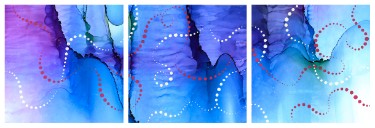THE PROCESS OF PEACE


DANIELLE FOUSHÉE
Jewels of the Mind
Ink on Paper on Board
2010
My artwork is about the emotional and spiritual space between memory and new beginnings. Stylized forms from nature create a dreamlike quality, offering suggestions of place that conflate elements of natural and mystical landscapes. Idyllic notions of “belonging” are abstractly explored as transcendental fantasies of the imagination. Layers of varying opacity, texture, materials, and processes add to a sense of longing for that which can t be found. Bright colors and graphic shapes contradict vague melancholic undertones and bring a sublime sense of optimism
and excitement for an unknowable, untouchable future. In a sense, my work fundamentally celebrates the simplicity of the present moment through a circuitous study of all that surrounds it.
My yoga practice is often a strong inspiration for my artwork. Yoga allows its practitioners to connect with and gain knowledge about the innermost and interconnected workings of their minds and bodies. My work comes from my own unique physical and spiritual experience. Perhaps a reflection of the (im)balance of the intuitive brain and the analytical brain, my work tends to swing back and forth on the continuum between uncontrolled application of pigment and precise layering of graphic elements.
Sometimes the two begin to overlap.
According to yoga philosophy, there are thousands of nadis, or energy channels, that govern the subtle body. Of these, the ida, pingala, and shushumna are the three most influential. Ida governs the intuitive right brain and parasympathetic nervous system. The analytic left-brain and sympathetic nervous system are governed by pingala. When these two channels of energy become balanced shushumna begins to take over, offering a more direct energetic path to peace, clarity, and enlightenment.
“The central doctrine of Yoga philosophy is that nothing exists beyond the mind and its consciousness, which is the only ultimate reality. The objective of this philosophy is to uproot misconceptions about the existence of external realities from the minds of men. It believes that it is
possible to reach this stage of self realization through regular practice of certain yogic meditative processes that bring a complete withdrawal or detachment from all false sources of knowledge and inculcates an inner sense of balanced calm and tranquility.” — Life Positive magazine
I explore chance encounters and controlled responses through my art-making practice. I am fascinated by the way in which the human condition—within cultures, communities, and individuals—is often characterized by habitual responses to various unpredictable situations. We tend to live in a state of inertia until some cathartic event causes us to change our path, usually for only a short time. At some point when we re not paying attention, we tend to revert to our old way of doing things. Yogic philosophy argues that this repetitious cycle of behaviors (called samskara) is caused by the karma we have created for ourselves. We must necessarily continue in this Groundhog Day scenario until we finally learn the lessons that bring about lasting positive change in our lives. Much of my work attempts to abstractly convey the process of releasing karma—not from a judgmental point of view, but more from an observational standpoint. Perhaps, my work is an illustration of the constant trial and error we experience through the waves of life. Our occasional breakthroughs lead to something less literal, representational, and dogmatic, and more balanced, free, creative, and aware.